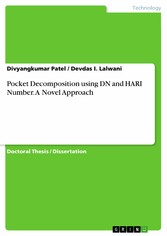Pocket Decomposition using DN and HARI Number. A Novel Approach
von: Divyangkumar Patel, Devdas I. Lalwani
GRIN Verlag , 2018
ISBN: 9783668659193
, 208 Seiten
Format: PDF
Kopierschutz: frei
Preis: 39,99 EUR
eBook anfordern 
Mehr zum Inhalt

Pocket Decomposition using DN and HARI Number. A Novel Approach
Doctoral Thesis / Dissertation from the year 2016 in the subject Engineering - Mechanical Engineering, grade: Distinction, Sardar Vallabhbhai National Institute of Technology, language: English, abstract: A 2.5D pocket milling is extensively used in aerospace, shipyard, automobile, dies and molds industries. In machining of 2.5D pockets, directional parallel tool-path and contour parallel tool-path are widely used. However, these tool paths significantly limit the machining efficiency. In the present work, an attempt has been made to generate a spiral tool path for machining of 2.5D star-shaped pocket for improving machining efficiency. The spiral tool path is developed using second order elliptic partial differential equation (PDE) and it is free from sharp corners inside the pocket region. Further, the implementation of proposed method is presented on complex non-star-shaped polygon, pocket bounded by free-form curve and pocket with island. The shape of pocket geometry, tool path strategy and various machining parameters (speed, feed rate and depth of cut) affect machining performance. However, the effect of the shape of a pocket geometry and tool path strategy on the performance of pocket machining is scarcely reported. Hence, an attempt has been made to investigate the effect of aspect ratio, feed rate and tool path strategies (zig-zag, spiral and contour parallel) on tool path length, cutting time, percentage utilization of a tool and average surface roughness in machining of AISI 304 stainless steel using design of experiments (DOE). From the findings of above experimental investigation, it was anticipated that there is a need to develop a method (or technique) for comparing different pocket geometry quantitatively and predict the effect of pocket geometry on pocket machining. A novel approach is reported for quantitative comparison of different pocket geometries using a dimensionless number, Divyang Number (DN). The concept and formula of DN are developed and DN is calculated for various pocket geometries. The guidelines for comparing pocket geometries based on DN and PUT (percentage utilization of tool) are reported. The results show that DN can be used to predict the quality of tool path prior to tool path generation. Further, an algorithm to decompose pocket geometry (parent geometry) into sub-geometries is developed that improves the efficiency of spiral tool path for bottle-neck pockets using HARI Number. The results indicate that decomposing pocket geometry with the new algorithm improves HARIN and removes the effect of bottle-necks. Furthermore, the algorithm for decomposition is extended for pockets that are bounded by free-form curves.









